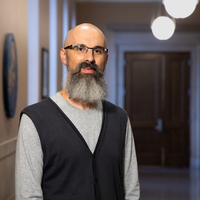Talks by Fabio Arlati
Panel Attraverso la Storia, V convegno SISEM per giovani studiosi, Padova 20-22 febbraio 2019.
Book Reviews by Fabio Arlati
Aevum, 2018
http://aevum.vitaepensiero.it/
Papers by Fabio Arlati

A la sombra de las catedrales: cultura, poder y guerra en la Edad Moderna, 2021, ISBN 978-84-18465-07-9, págs. 743-758, 2021
Durante el episcopado de Carlo Borromeo, la Iglesia milanesa estableció una vasta red de institut... more Durante el episcopado de Carlo Borromeo, la Iglesia milanesa estableció una vasta red de institutos de mujeres sin clausura -conservatorios, colegios, casas de las ursulinas -responsables de la asistencia social de las mujeres en dificultad. El objetivo de esta intervención es arrojar luz sobre las mujeres que dirigían estos institutos, pertenecientes a diferentes congregaciones femeninas, sin clausura ni votos solemnes, promovidas por el mismo arzobispo. Estas mujeres semirreligiosas profesaban un ideal de vida mixta que combinaba contemplación y acción: para ellas la perfección era alcanzable sobre todo a través del compromiso educativo y asistencial con otras mujeres. Aunque estas congregaciones no encajaban en el modelo religioso monástico impuesto por el Concilio de Trento, Carlo Borromeo apreció la finalidad educativa y asistencial de las semirreligiosas, ofreciendo así un ejemplo a otros obispos italianos.

Università Cattolica del Sacro Cuore, May 21, 2021
A dispetto della legislazione claustrale tridentina e post-tridentina, tra XVI e XVII secolo si a... more A dispetto della legislazione claustrale tridentina e post-tridentina, tra XVI e XVII secolo si assistette all’emergere in Italia, in Europa e nei paesi di missione di numerose congregazioni semireligiose femminili insegnanti, senza clausura e senza voti solenni, fondate, co-fondate o dirette dai padri della Compagnia di Gesù, che si ispiravano alle Costituzioni e alla spiritualità ignaziana, specie nell’apostolato educativo. Attraverso un approfondito scavo archivistico, il presente studio offre un vasto censimento delle numerose case di “gesuitesse” presenti in Italia tra Cinquecento e Seicento, mostrando, tramite l’analisi delle reti di relazioni tra questi istituti nonché delle peculiarità economiche, giuridiche, educative e spirituali delle semireligiose rispetto alle monache claustrali, la sostanziale compattezza e unità di questo fenomeno, fondato sulla comune identità gesuitica. Con ciò si intende, inoltre, far luce sui contrasti e sulle contraddizioni legati all’affermazione delle gesuitesse, che portarono ad aspri scontri interni alla Compagnia di Gesù, a diversi processi inquisitoriali e a duri conflitti giurisdizionali tra poteri secolari ed ecclesiastici.In spite of the Tridentine and post-Tridentine cloistered legislation, the 16th and 17th centuries witnessed the foundation in Italy, Europe and the mission countries of numerous semi-religious female congregations, without clausura and without solemn vows, founded, co-founded or directed by the fathers of the Society of Jesus. These congregations, called “Jesuitesses”, were inspired by the Jesuit Constitutions and Ignatian spirituality, especially in the educational apostolate. Through an in-depth archival research, the present study offers a vast census of the numerous houses of Jesuitesses present in Italy between the Sixteenth and Seventeenth centuries, showing, through the analysis of the network of relations between these institutes as well as the economic, juridical, educational and spiritual peculiarities of the semi-religious compared to the cloistered nuns, the substantial compactness and unity of this phenomenon, based on a common Jesuit identity. The aim is also to shed light on the contrasts and contradictions related to the affirmation of the Jesuitesses, which led to bitter internal clashes within the Society of Jesus, various inquisitorial trials and harsh jurisdictional conflicts between secular and ecclesiastical powers
Il presente articolo indaga il contesto familiare, il profilo culturale e il percorso spirituale ... more Il presente articolo indaga il contesto familiare, il profilo culturale e il percorso spirituale della contessa Margherita Trivulzio Borromeo, zia di Carlo e madre di Federico, la quale fond\uf2 nel 1590 ad Arona, in diocesi di Milano, una congregazione femminile senza clausura di \u201cgesuitesse\u201d, in collaborazione con il proprio direttore spirituale gesuita, Giovanni Mellino. Sul modello di Ludovica Torelli e delle orsoline congregate, l\u2019esperienza di Margherita testimoni\uf2 l\u2019intraprendenza di un laicato femminile devoto, favorevole ad una vita religiosa attiva nella Milano borromaica. L\u2019originale sensibilit\ue0 della contessa e il decisivo contributo di Mellino fecero del collegio di Arona un innovativo istituto semireligioso, finalizzato all\u2019educazione di donne sia nobili sia popolane, sotto la guida dei gesuiti e la protezione arcivescovile
Premio Istituto Sangalli per la storia religiosa, 2024
Peer-review is the cornerstone of the scientific evaluation of a book. All FUP's publications und... more Peer-review is the cornerstone of the scientific evaluation of a book. All FUP's publications undergo a peer-review process by external experts under the responsibility of the Editorial Board and the Scientific Boards of each series (DOI 10.36253/fup_best_practice.3). In order to strengthen the network of researchers supporting FUP's evaluation process, and to recognise the valuable contribution of referees, a Referee List is published and constantly updated on FUP's website (DOI 10.36253/fup_referee_list). Firenze University Press Editorial Board M. Garzaniti (Editor-in-Chief), M.

Durante el episcopado de Carlo Borromeo, la Iglesia milanesa estableció una vasta red de institut... more Durante el episcopado de Carlo Borromeo, la Iglesia milanesa estableció una vasta red de institutos de mujeres sin clausura – conservatorios, colegios, casas de las ursulinas – responsables de la asistencia social de las mujeres en dificultad. El objetivo de esta intervención es arrojar luz sobre las mujeres que dirigían estos institutos, pertenecientes a diferentes congregaciones femeninas, sin clausura ni votos solemnes, promovidas por el mismo arzobispo. Estas mujeres semirreligiosas profesaban un ideal de vida mixta que combinaba contemplación y acción: para ellas la perfección era alcanzable sobre todo a través del compromiso educativo y asistencial con otras mujeres. Aunque estas congregaciones no encajaban en el modelo religioso monástico impuesto por el Concilio de Trento, Carlo Borromeo apreció la finalidad educativa y asistencial de las semirreligiosas, ofreciendo así un ejemplo a otros obispos italianos.

«Inter Scillam et Caribdim» : Caterina Perabò, il Collegio di S. Orsola di Varese e la difesa dello Stato laicale nelle controversie giurisdizionali milanesi (1597-1618), 2019
This essay shows how, despite the reforms initiated by the Council of Trent and post-Tridentine b... more This essay shows how, despite the reforms initiated by the Council of Trent and post-Tridentine bishops – starting with Carlo Borromeo – a strong demand for secularity and autonomy from ecclesiastical jurisdiction persisted in a part of the female religious world tied especially with the Company of St. Ursula. Against the backdrop of the complicated Milanese jurisdictional disputes of the late 16th century, the congregation of Ursulines’ rebellion in Varese, led by the noblewoman Caterina Perabò against Federico Borromeo’s episcopal authority, gave rise to a political-juridical conflict that opposed the major officers of the diocese to the ones of the State of Milan for more than twenty years. The dispute assumed an exemplary character for other congregations and pia loca of Milan, longing to follow Ursulines’ example and get free from ecclesiastical jurisdiction. Thanks to the protection of the Senate, the governor of Milan and the king of Spain, Caterina, following the example of Ludovica Torelli, succeeded in creating a noncloistered secular college of education, reaffirming laywomen’s autonomy of action.
Fabio Arlati, 2020
Il presente articolo indaga il contesto familiare, il profilo culturale e il percorso spirituale ... more Il presente articolo indaga il contesto familiare, il profilo culturale e il percorso spirituale della contessa Margherita Trivulzio Borromeo, zia di Carlo e madre di Federico, la quale fondò nel 1590 ad Arona, in diocesi di Milano, una congregazione femminile senza clausura di “gesuitesse”, in collaborazione con il proprio direttore spirituale gesuita, Giovanni Mellino. Sul modello di Ludovica Torelli e delle orsoline congregate, l’esperienza di Margherita testimoniò l’intraprendenza di un laicato femminile devoto, favorevole ad una vita religiosa attiva nella Milano borromaica. L’originale sensibilità della contessa e il decisivo contributo di Mellino fecero del collegio di Arona un innovativo istituto semireligioso, finalizzato all’educazione di donne sia nobili sia popolane, sotto la guida dei gesuiti e la protezione arcivescovile.

Rivista di Storia del Cristianesimo, 2019
This essay shows how, despite the reforms initiated by the Council of Trent and post-Tridentine b... more This essay shows how, despite the reforms initiated by the Council of Trent and post-Tridentine bishops – starting with Carlo Borromeo – a strong demand for secularity and autonomy from ecclesiastical jurisdiction persisted in a part of the female religious world tied especially with the Company of St. Ursula. Against the backdrop of the complicated Milanese jurisdictional disputes of the late 16th century, the congregation of Ursulines’ rebellion in Varese, led by the noblewoman Caterina Perabò against Federico Borromeo’s episcopal authority, gave rise to a political-juridical conflict that opposed the major officers of the diocese to the ones of the State of Milan for more than twenty years. The dispute assumed an exemplary character for other congregations and pia loca of Milan, longing to follow Ursulines’ example and get free from ecclesiastical jurisdiction. Thanks to the protection of the Senate, the governor of Milan and the king of Spain, Caterina, following the example of Ludovica Torelli, succeeded in creating a noncloistered secular college of education, reaffirming laywomen’s autonomy of action.
Books by Fabio Arlati
Firenze University Press, 2024
The book investigates the emergence in Italy between the 16th and 17th centuries of the so-called... more The book investigates the emergence in Italy between the 16th and 17th centuries of the so-called “Jesuitesses”, i.e. congregations of laywomen inspired by the spirituality of the Society of Jesus. Sources in the Archivum Romanum Societatis Iesu show that in the early modern period various Jesuit spiritual directors helped many women, especially nobles, to set up communities without eclosure, dedicated to practices of spiritual improvement and educational activities similar to those of their confessors. In addition to providing a census of these congregations, the study examines the innovations of their forma vitae and analyzes the attitudes, at times supportive and at times oppositional, that territorial princes, bishops, Jesuit generals, the Holy Office, Roman congregations, and popes took towards the Jesuitesses.











Uploads
Talks by Fabio Arlati
Book Reviews by Fabio Arlati
Papers by Fabio Arlati
Books by Fabio Arlati